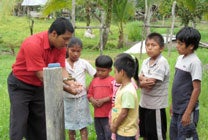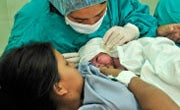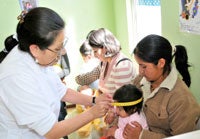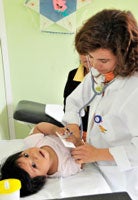Introduction
Health and the Millennium Development Goals:
From Commitment to Action
The Millennium Development Goals are the most ambitious endeavor ever pursued against human deprivation and the first to place health at the center of development. They give us an unparalleled opportunity to improve health and equity by mobilizing coordinated multisectoral action to fight disease and improve the social determinants of health.
Dr. Mirta Roses Periago
Director
Pan American Health Organization
Introduction
 For countries in the Americas and around the world, the United Nations Millennium Development Goals (MDGs) have proven to be both challenging and catalytic, which was the intent of the 189 heads of government who endorsed the Millennium Declaration at the dawn of the 21st century. In signing on to the MDGs, leaders of low- and middle-income countries pledged to significantly step up efforts to reduce poverty and improve quality of life for their most vulnerable people, while representatives of high-income countries promised to increase support for their efforts. Together these leaders expressed an unprecedented new global commitment to “making the right to development a reality for everyone and to freeing the entire human race from want.”
For countries in the Americas and around the world, the United Nations Millennium Development Goals (MDGs) have proven to be both challenging and catalytic, which was the intent of the 189 heads of government who endorsed the Millennium Declaration at the dawn of the 21st century. In signing on to the MDGs, leaders of low- and middle-income countries pledged to significantly step up efforts to reduce poverty and improve quality of life for their most vulnerable people, while representatives of high-income countries promised to increase support for their efforts. Together these leaders expressed an unprecedented new global commitment to “making the right to development a reality for everyone and to freeing the entire human race from want.”
For Latin America and the Caribbean, the MDG call to action has resonated with a regional development agenda focused on reducing poverty and the gaps between rich and poor that have made the Americas the most unequal region in the world. Mandates from the Summit of the Americas meetings, the general assemblies of the Organization of American States (OAS), the Pan American Health Organization (PAHO) Directing Council meetings, and other regional forums have repeatedly urged policies and programs aimed at reducing inequity and improving living conditions for the poor.
 The Region’s political leaders reiterated their commitment to the MDGs at the 2003 International Conference on the MDGs in Latin America and the Caribbean, held in Brasilia, and at the Summits of the Americas in Monterrey in 2004, Mar del Plata in 2005, and Port of Spain in 2009. The 2003 Brasilia Declaration, in particular, was a strong call to action that lay out in considerable detail the responsibilities of states, legislators, civil society, and the international community in advancing the MDGs. The Region was well represented at both the 2005 and 2010 MDG review summits, and United Nations (UN) agencies active in the Americas all contributed to the 2005 and 2010 MDG progress reports, under the coordination of the UN Economic Commission for Latin American and the Caribbean (ECLAC).
The Region’s political leaders reiterated their commitment to the MDGs at the 2003 International Conference on the MDGs in Latin America and the Caribbean, held in Brasilia, and at the Summits of the Americas in Monterrey in 2004, Mar del Plata in 2005, and Port of Spain in 2009. The 2003 Brasilia Declaration, in particular, was a strong call to action that lay out in considerable detail the responsibilities of states, legislators, civil society, and the international community in advancing the MDGs. The Region was well represented at both the 2005 and 2010 MDG review summits, and United Nations (UN) agencies active in the Americas all contributed to the 2005 and 2010 MDG progress reports, under the coordination of the UN Economic Commission for Latin American and the Caribbean (ECLAC).
PAHO Mandates Supporting the MDGs, 2000-2010
|
 The MDGs assign a central role to health. Three of the eight goals (4, 5 and 6) address specific health challenges, while two other goals (1 and 8) and at least three other targets are inextricably linked with health (see Box 2). This reflects the broad 21st-century consensus that health is both an outcome of and an essential input for social and economic development. Indeed, the MDG framework shows that health status and life expectancy have become proxy indicators for a well-functioning society.
The MDGs assign a central role to health. Three of the eight goals (4, 5 and 6) address specific health challenges, while two other goals (1 and 8) and at least three other targets are inextricably linked with health (see Box 2). This reflects the broad 21st-century consensus that health is both an outcome of and an essential input for social and economic development. Indeed, the MDG framework shows that health status and life expectancy have become proxy indicators for a well-functioning society.
Though the MDG framework does not include every current global health priority—chronic diseases are a notable omission—the health goals address major contributors to the burden of illness among the world’s most vulnerable populations. Equally important, the other goals address the major social determinants of health status and health inequalities, reinforcing an approach promoted by both the World Health Organization (WHO) and PAHO. With this focus, the MDGs have opened up unprecedented opportunities for promoting action and investments in health and its social determinants at the local, national, regional, and global levels.
The Millennium Development Goals
|
 While PAHO/WHO’s efforts to advance the MDGs started shortly after the Millennium Declaration, the overarching framework for this work was established in 2004 at PAHO’s 45th Directing Council, when the Region’s health leaders made the MDGs a top priority and pledged to strengthen political commitment at all levels of government (CD45.R3).
While PAHO/WHO’s efforts to advance the MDGs started shortly after the Millennium Declaration, the overarching framework for this work was established in 2004 at PAHO’s 45th Directing Council, when the Region’s health leaders made the MDGs a top priority and pledged to strengthen political commitment at all levels of government (CD45.R3).
At that moment, no country in the Americas seemed likely to reach all the MDG targets, according to the report “Millennium Development Goals and Health Targets,” which was prepared by PAHO’s Secretariat in anticipation of the 2005 UN General Assembly and which formed the basis for the 2004 Directing Council resolution. As a whole the Region was not progressing sufficiently to achieve the targets for infant and maternal mortality, nor was it on track to halt and reverse the spread of HIV by 2015. The prospects for controlling and reversing malaria and tuberculosis and for meeting the targets on access to water, sanitation, and essential drugs were unclear. To accelerate progress, the study urged a “Pan American approach” in which governments, civil society, the private sector, and international organizations would work together through new partnerships and with increased development assistance to advance the MDGs.
 In response to the report, the ministers committed to a series of actions in their countries and internationally, aimed at accelerating MDG progress. These included promoting intersectoral partnerships, intensifying action on national health development and social protection, improving measurement and monitoring of MDG progress, and promoting greater civil society involvement in efforts to advance the MDGs. The ministers called on PAHO’s Secretariat to support their efforts and to mainstream the MDG health priorities in all its technical cooperation programs, focusing special attention on countries and population groups with the greatest needs.
In response to the report, the ministers committed to a series of actions in their countries and internationally, aimed at accelerating MDG progress. These included promoting intersectoral partnerships, intensifying action on national health development and social protection, improving measurement and monitoring of MDG progress, and promoting greater civil society involvement in efforts to advance the MDGs. The ministers called on PAHO’s Secretariat to support their efforts and to mainstream the MDG health priorities in all its technical cooperation programs, focusing special attention on countries and population groups with the greatest needs.
These commitments to accelerating progress on the health-related MDGs were reinforced by the Health Agenda for the Americas 2008-2017, launched by the Region’s ministers of health prior to the opening of the OAS General Assembly in Panama in 2007. The new regional agenda was aligned with the MDGs both explicitly and in its focus on the social determinants of health and expanded social protection with the aim of reducing inequities between and within countries.
 PAHO/WHO member countries followed up on these commitments by incorporating the MDGs into their national health and development planning processes, by developing new initiatives, and by strengthening efforts in such areas as child and maternal mortality that were already oriented toward the MDGs. These efforts found strong support from the international donor community, particularly Spain’s MDG Achievement Fund, from PAHO’s Secretariat, and from other UN partners.
PAHO/WHO member countries followed up on these commitments by incorporating the MDGs into their national health and development planning processes, by developing new initiatives, and by strengthening efforts in such areas as child and maternal mortality that were already oriented toward the MDGs. These efforts found strong support from the international donor community, particularly Spain’s MDG Achievement Fund, from PAHO’s Secretariat, and from other UN partners.
PAHO/WHO technical cooperation in support of its member countries’ efforts in this area has included both ongoing programs and special initiatives explicitly focused on the MDGs. The former include actions to improve infant and young child nutrition, reduce child and maternal mortality, control HIV and other infections, promote access to safe drinking water and sanitation, strengthen and reorganize health systems, and expand social protection in health. The latter include technical cooperation focusing on four main areas: (a) strengthening the evidence base for and monitoring progress toward the achievement of the MDGs, (b) advocacy and consensus building, (c) development and implementation of regional MDG plans and strategies, and (d) mobilizing alliances and resources. To advance the MDGs at the local level, PAHO/WHO also developed the “Faces, Voices and Places of the MDGs” initiative, an integrated, intersectoral, and multipartner effort that engages the Region’s most vulnerable communities to address gaps in MDG progress that are concealed behind national averages.
 All these efforts have contributed to significant MDG progress in the Americas over the past several years. In contrast to 2004, the Region as a whole is today on track to meet most of the MDG health targets, including those on hunger, child mortality, and water and sanitation. Among the greatest gains have been reductions in child malnutrition, expanded access to water and sanitation, and declines in incidence and mortality from malaria and tuberculosis. Assessing progress in some areas—especially maternal mortality—is difficult because of data problems. But only the goal of halting and reversing the HIV epidemic by 2015 appears to remain well out of the Region’s reach, despite major advances in expanding treatment and prevention of HIV.
All these efforts have contributed to significant MDG progress in the Americas over the past several years. In contrast to 2004, the Region as a whole is today on track to meet most of the MDG health targets, including those on hunger, child mortality, and water and sanitation. Among the greatest gains have been reductions in child malnutrition, expanded access to water and sanitation, and declines in incidence and mortality from malaria and tuberculosis. Assessing progress in some areas—especially maternal mortality—is difficult because of data problems. But only the goal of halting and reversing the HIV epidemic by 2015 appears to remain well out of the Region’s reach, despite major advances in expanding treatment and prevention of HIV.
At the same time, most of this progress has been uneven across and especially within countries. A few countries remain behind schedule and are unlikely to meet targets for which the Region as a whole is on track. But in virtually all the countries in the Region there are vulnerable communities and population groups that have benefitted little or not at all from MDG progress at the national level. The need to focus especially on these groups has been a tenet of PAHO/WHO’s efforts to advance the MDGs and is one of the key lessons learned from the Region’s experiences in this area.
Other lessons—presented in detail in Chapter 3 of this report—include the need to adapt targets and indicators to ensure they are meaningful in the regional context, the urgency of building human capital at the local level, and the importance of incorporating climate change and sustainability issues into the regional development agenda. It will be important to apply all these lessons to consolidate gains and accelerate MDG progress in the years remaining before 2015 as well as to ensure sustainable progress in the years beyond.
 Go to next Chapter
Go to next Chapter

